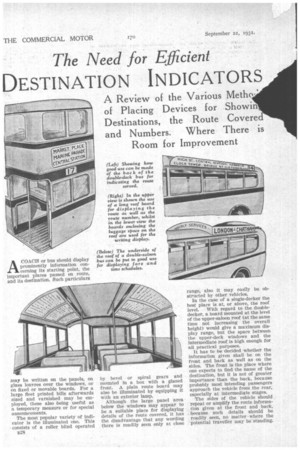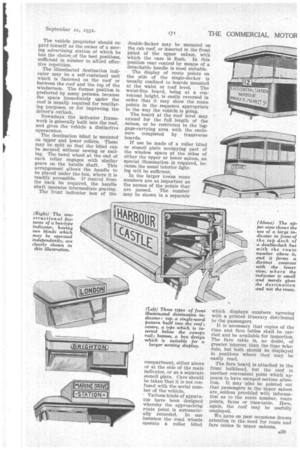The Need for Efficient
Page 46

Page 47

If you've noticed an error in this article please click here to report it so we can fix it.
DESTINATION INDICATORS
A Review of the Various Metho' of Placing Devices for Showin Destinations, the Route Covere and Numbers. Where There is Room for Improvement
ACOACH or bus should display prominently information concerning its starting point, the important places passed en route, and its destination. Such particulars may be written on the panels, on glass louvres over the windows, Or on fixed or movable boards. For a large fleet printed bills afterwards sized and varnished may be employed, these also 'being useful as a temporary measure or for special announcements.
The most popular variety of indicator is the illuminated one. This consists of a roller blind operated B28 by bevel or spiral gears and mounted in a box with a glazed front. A plain route board may also be illuminated by equipping it with an exterior lamp.
Although the large panel area below the windows may appear to be a suitable place for displaying details of the route covered, it has the disadvantage that any wording there is readily seen only at close range, also it may easily be obstructed by other vehicles.
In the case of a single-decker the best place is at, or above, the roof level. With regard to the doubledecker, a board mounted at the level of the upper-saloon roof (at the same time not increasing the overall height) would give a maximum display range, but the space between the upper-deck windows and the intermediate roof is high enough for all practical purposes.
It has to be decided whether the information given shall be on the front and back as well as on the sides. The front is the place where one expects to find the name of the destination, but it is not of greater importance than the back, because • probably most intending passengers approach the vehicle from the rear, especially at intermediate stages.
The sides of the vehicle should repeat or amplify the route information given at the front and back, because such details should be readily seen, no matter where the potential traveller may be standing. The vehicle proprietor should regard himself as the owner of a moving advertising station of which he has the choice of the best positions, sufficient in number to afford effective repetition.
The illuminated destination indicator may be a self-contained unit which is fastened on the roof or between the roof and the top of the windscreen. The former position is preferred by many persons, because the space immediately under the roof is usually required for ventilating purposes, or for improving the driver's outlook.
Nowadays the indicator framework is generally 'built into the roof, and gives the vehicle a distinctive appearance.
The destination blind is mounted on upper and lower rollers. These may be split so that the blind can be secured without sewing or nailing. The bevel wheel at the end of each roller engages with similar gears on the handle shaft. This arrangement allows the handle to be placed under the box, where it is readily accessible. If Control from the back be required, the handle shaft operates intermediate gearing.
The front indicator box of the
double-decker may be mounted on the cab roof, or inserted in the front panel of the upper saloon, with which the case is flush. In this position rear control by means of a detachable handle is most suitable.
The display of route points on the side of the single-decker is usually confined to boards mounted at the waist or roof level. The waist-line board, being at a convenient beight, is easily reversed in order that it may show the route points in the sequence appropriate to the way the vehicle is going.
The board at the roof level may extend for the full length of the saloon, or be restricted to the luggage-carrying area with the enclosure completed by transverse boards.
If use be made of a roller blind or stencil plate occupying part of the window space at the sides of either the tipper or lower saloon, no special illumination is required, because the usual interior lighting will be sufficient.
In the larger towns route numbers are as important as the names of the points that are passed. The number may be shown in a separate
compartment, either above or at the side of the main indicator, or as a separate stencil plate. Care should be taken that it is not confused with the serial number of the vehicle.
Various kinds of apparatus have been designed whereby the approaching route point is automatically recorded. In one instance the road wheels operate a roller blind which displays numbers agreeing with a printed itinerary distributed to the passengers.
It is necessary that copies of the time and fare tables shall be carried and be available for inspection. The fare table is, no doubt, of greater interest than the time Schedule, but both should be displayed in positions where they may be easily read.
The fare board is attached to the front bulkhead, but the roof is another convenient point which appears to have escaped serious attention. It may also be pointed out that passengers in the upper saloon are seldom provided with information as to the route number, route points, fares or time-table. Here, again, the roof may be usefully employed.
We have on past occasions drawn attention to the need for route and fare tables in upper saloons.




































































































